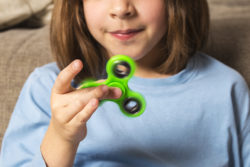
Fidget spinner has quickly become a household term. In fact, it’s likely you have one or more of these little gadgets in your home.
The idea behind fidget spinners is that they help kids stop fidgeting and focus their attention on the task at hand. Manufacturers have even promoted them as having health benefits for children with a variety of conditions, including ADHD. Do experts agree?
“I call it the smart phone phenomenon. Children become so focused on these gadgets to the detriment of everything else.”
–Dr. Bela Sood, child and adolescent psychiatrist and ADHD expert with CHoR’s Virginia Treatment Center for Children
Dr. Sood explained that while in theory fidget spinners provide an outlet for motor overflow, in reality not enough research has been done to examine if they truly provide benefit for children with ADHD.
One thing is for certain. Fidget spinners have gained a great following, in part because they’re fun to use and the toy industry has been successful in making parents feel like they need to get them for their children. On the other hand, the educational setting has seen quite a bit of controversy over this craze.
“Generally with ADHD, or any other condition with a mental health impact, we work with schools to provide accommodations. A structured way to go about this is to allow children with hyperactivity to get up and move around every 10 minutes in a useful manner. Make them the teacher’s helper and have them take things from one place in the classroom to another,” added Dr. Sood. “Fidget spinners are the latest in what I call ‘community trends’ and school leaders are being forced to make a determination on how to deal with them.”
 These leaders are faced with what seems like an endless stream of questions, including:
These leaders are faced with what seems like an endless stream of questions, including:
- If fidget spinners are used in the classroom as a therapeutic tool, are they actually contributing to improvements in performance?
- Which children in particular benefit from them? Are they the only ones who should use them?
- Are fidget spinners distracting the users and other students more than they’re helping?
- Should they be allowed only during certain times throughout the school day?
Due to the lack of research in this arena, Dr. Sood’s professional recommendation is that fidget spinners be used with a very limited population for therapeutic purposes at this point. For the general population, it’s a toy and parents should treat it as such with regard to access and how much time they allow their children to use it.
“Not all brains respond to the same things in the same manner,” concluded Dr. Sood. “There may be a time and place for the fidget spinner, but if it is to have staying power it will have to go through scientific investigation.”
